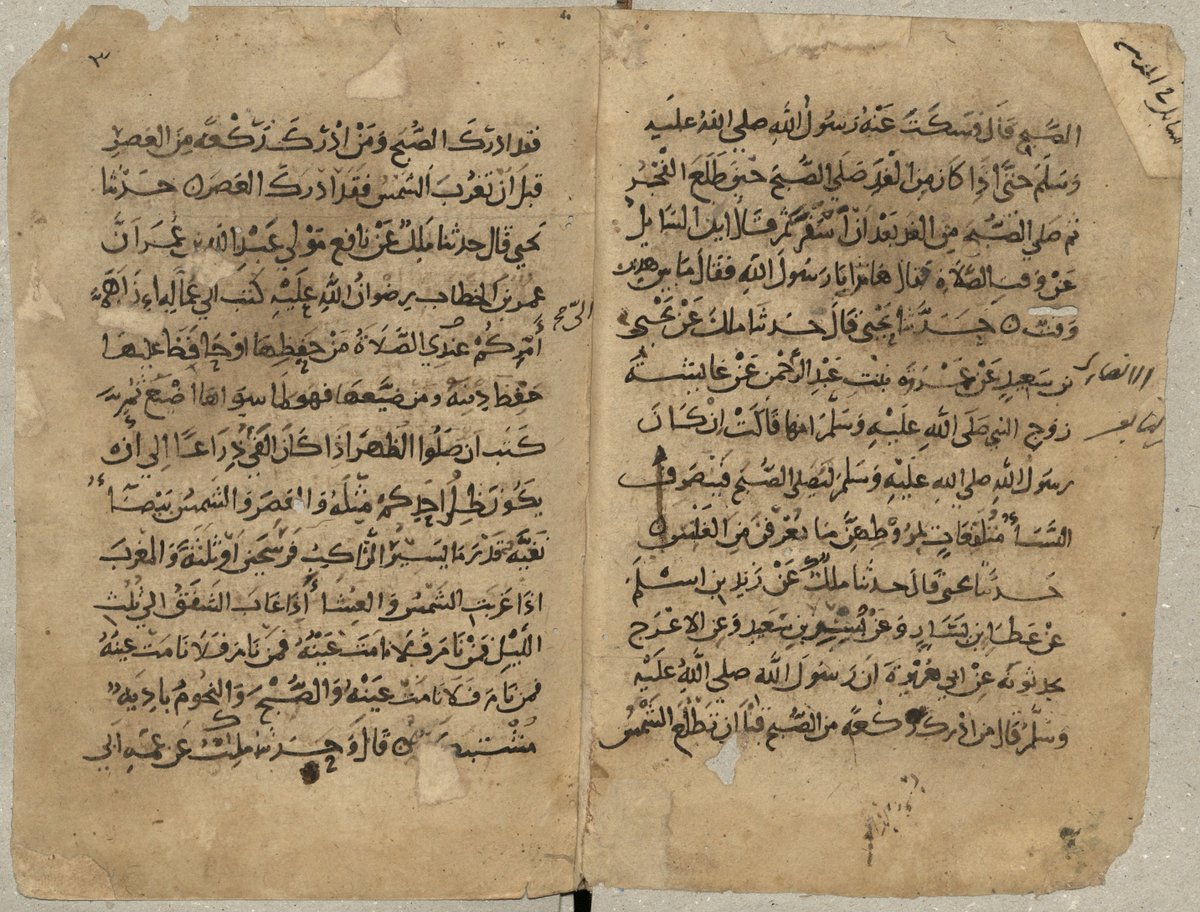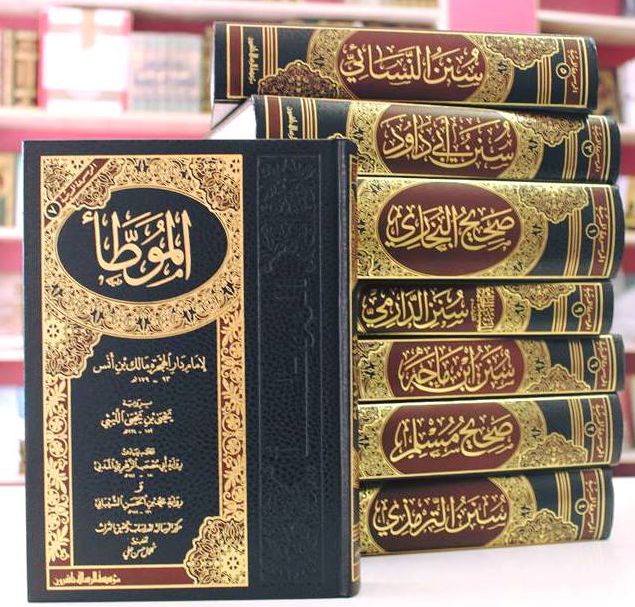Current Section: model

Lesson The Documentation of the Sunnah and Its Most Important Books
The scholars of Islam devoted their lives to the recording and preservation of the Sunnah, distinguishing sound narrations from weak ones, and detailing the state and condition of its narrators in a manner unprecedented throughout the entirety of human history.

Meaning of Documentation the Prophetic Sunnah
It is the writing and recording of what was reported from the Prophet Muhammad ﷺ in terms of his speech, action, or tacit approval, and collecting that in books and compilations.
The process of transcribing the Sunnah and writing the hadith passed through several stages:
The First Stage:
Recording of the Sunnah during the time of the Prophet ﷺ and his companions, which took place in the first century AH (After Hijra). The Prophet ﷺ forbade the documentation of his hadiths at the beginning of Islam for fear being mixed with the Quran.
On the authority of Abu Saeed Al-Khudri (may Allah be pleased with him) that the Messenger of Allah ﷺ said: “Do not write about me, and whoever wrote about me anything other than the Quran, let him erase it. Narrate on my on my behalf, for there is no problem with that” (Muslim 3004).
Because of this, the hadiths of the Prophet ﷺ were preserved in the heart, and they were transmitted orally through the narration. Later, the Prophet ﷺ authorized some of the Companions to document the hadiths.
Abdullah bin Amr (may Allah be pleased with them) narrates: I used to write down everything that I heard from the Messenger of Allah ﷺ that I wanted to memorize. However, the Quraysh forbade me and said: 'Do you write down everything you hear from the Messenger of Allah ﷺ, a human being who speaks in anger as well as calmness?'. So I stopped writing and mentioned this to the Messenger of Allah ﷺ, who gestured with his finger to his mouth and said: “Write, for by the One in Whose Hand my soul is, nothing comes out of it except the truth.” (Sunan Abi Dawood 3646).
Al-Waleed ibn Muslim narrated on the authority of Al-Awza’i who narrated that Abu Hurayrah (may Allah be pleased with him) said: “When Allah the Exalted conquered Mecca for the Messenger of Allah ﷺ, the Messenger stood among the people, praised Allah and extolled Him.” [Abu Hurayrah then mentioned the sermon and and said:] So Abu Shah---a man from the people of Yemen--- stood and said: "[Kindly] write for me O Messenger of Allah.' The Messenger of Allah ﷺ said: “Write for Abu Shah.” Al-Waleed said: "I asked Al-Awza’i: What is he saying 'Write for me, Messenger of Allah?' He [Al-Awza'i] said: "This sermon that he heard from the Messenger of Allah .” Al-Bukhari (2434), and Muslim (1355).
The Second Stage
Recording of hadith towards the end of the era of the Tabi‘een in the 2nd century AH. This writing was characterized by the general codification of the Prophetic Sunnah, but it did not have a specific order or organization to it. The first who took interest in this was Umar ibn Abdulaziz (may Allah have mercy on him). So he ordered the two Imams Ibn Shihab az-Zuhri and Abu Bakr ibn Hazm to collect the Sunnah and wrote to the farthest of places: "Look into the Hadith of the Messenger of Allah and collect it and memorize it; for I fear the extinction of knowledge and the departure of scholars."
Imam al-Zuhri (may Allah have mercy on him) was the first to write down hadith per his command, and that was the beginning of the general documentation of the Sunnah and hadiths.
Authorship of the Sunnah in the form of classified and catalogued books. This was done either by specific chapters like Faith, Knowledge, Purification, Prayer, etc. or by the authority or source of the chain of narration such as Abu Bakr, Umar, etc.

During this stage, The Muwatta of Imam Malik bin Anas (may Allah have mercy on him) was authored. This stage was characterized by the organization and incorporation of the sayings of the Prophet ﷺ with the statements of the Companions and their descendants along with their fatwas (legal verdicts).
The Fourth Stage consisted of the authorship of the statements of the Prophet ﷺ exclusively, and gathering them and organizing them without mixing them with the statements of the Companions and their descendants, except a small amount that is essential to the context. This stage started from the 3rd century AH. The most famous books that were authored during this stage were: The Musnad of Imam Ahmad, the Musnad of Al-Humaidi, and others.

The recording of hadith reached its climax in the middle of the 3rd century AH, when Imam al-Bukhari authored Sahih al-Bukhari, and Imam Muslim authored Sahih Muslim, and the works of Sunan works were published such as: The Sunan of Abu Dawood, The Sunan of At-Tirmidhi, the Sunan of An-Nasa'i, Sunan of Ibn Rajah, Sunan of Ad-Darimi, and other works from the famous books of hadith.
Among the numerous books of the Prophetic Sunnah, six books came to be widely known: Sahih Al-Bukhari, Sahih Muslim, as well as Sunans of: Abi Dawood, Ibn Majah, An-Nasa’i, and At-Tirmidhi.

Sunan of Al-Darmi, Musnad of Imam Ahmad, and the Muwatta of Imam Malik were additional works that also became renowned.
Definition of the Six Books
The most famous books of the Prophetic Sunnah are collectively known as the Six Books, consisting of the following books:
Sahih Al-Bukhari (d. 256 AH)
It is one of the comprehensive books which collected everything that reached the author from the hadith of the Messenger of Allah ﷺ with regards to creed, acts of worship, transactions, battles, exegesis, and virtues. The author adhered strictly to the authenticity of the hadiths, such that it came to be known as the most authentic book after the Noble Quran.
Sahih Muslim (d. 261 AH)
It is also one of the comprehensive books in which the author adhered strictly to the authenticity of the hadiths, albeit with conditions that were lighter than the conditions of Al-Bukhari, and it is considered the second most authentic work in hadith after the book of Al-Bukhari.
3. The Sunan of Abu Dawood (d. 275 AH)
It is from the books of Sunan, whose chapters are arranged according to the chapters of fiqh (jurisprudence). His book includes narrations graded Sahih (authentic) and Hasan (very good). Weak hadiths are rarely mentioned in it.
Sunan At-Tirmidhi (d. 279 AH)
It is one of the comprehensive books that collected everything that reached the author from the hadith of the Messenger of Allah ﷺ regarding creed, acts of worship, dealings/transactions, battles, Quranic exegesis, and virtues. It does not adhere to the criteria of authenticity of narrations, so it contains hadiths that are Sahih (authentic), Hasan (sound), and Da'eef (weak).
5. Sunan An-Nisa'i (d. 303 AH)
It is also organized based on the chapters of Fiqh (Islamic Jurisprudence), and contains narrations that are Sahih (authentic), Hasan (sound), and Da'eef (weak).
6. Sunan Ibn Majah (d. 273 AH)
It is also organized based on the chapters of Fiqh (Islamic Jurisprudence), and contains narrations that are Sahih (authentic), Hasan (sound), Da'eef (weak), and Da'eef Mardood (rejected).
Al-Imam Al-Hafidh Abu al-Hajjaj al-Mizzi (d. 742 AH) said:
“As for the Sunnah, Allah has guided to it memorizers who understand, expert scholars, and entrusted critics, who prevent distortion from exaggerators, plagiarism from fabricators, and interpretation of the ignorant. They diversified its authorship and excelled in its recording from various ways and many sources in order to preserve the Sunnah and out of fear of losing it. The best, most adequate, the most accurate, with the least amounts of mistakes, the most useful, the most beneficial, the most blessed, the easiest provision, and the most widely accepted -by those who agree and those who disagree with it-, and the most regarded position with specialists as well as the masses: "The Sahih of Abu Abdullah Muhammad ibn Ismail al-Bukhari," followed by "The Sahih of Abu Al-Husayn Muslim ibn Hajjaj an-Naysaburi," followed by the book "As-Sunan" by Abu Dawood Sulaiman ibn al-Ash‘ath As-Sajastani, followed by the book "Al-Jami‘" of Abu ‘Isa Muhammad ibn ‘Isa at-Tirmidhi, followed by the book "As-Sunan" by Abu Abdulrahman Ahmad ibn Shu‘ayb an-Nasa'i, followed by the book "As-Sunan" of Abu Abdullah Muhammad ibn Yazeed, also known as Ibn Rajah al-Qazwini, although his book did not reach the level of the rest.
Each one of these "Six Books" has features known to its experts. These books became popular amongst the masses and spread throughout the lands of Islam, and great benefit was attained through them and the students of knowledge hastened to learn them.” (Tahdheeb al-Kamal (1/147)).
A Muslim can learn the grading of a hadith if it is an acceptable Sahih or a rejected Da'eef hadith by going back to the scholars and experts who specialize in Hadith Sciences, for they studied hadiths from the level of authenticity of their chain, their content, as well as their level of acceptability and rejection.

There are a number of books authored and written about this topic. In addition, there are a number of apps and trusted online search engine platforms that allow one to know Sahih (authentic) hadiths from Da'eef (inauthentic) ones.
Some apps and online search platforms that help with recognizing the level of authenticity of hadiths:
The Hadith Encyclopedia on the Al-Dorar As-Siniyyah website which encompasses hundreds of thousands of hadiths with the verdicts of Hadith scholars (early, late, and contemporary) on them. The website can be accessed through the following website: https://dorar.net/hadith


